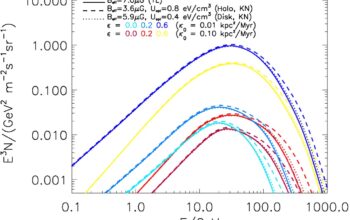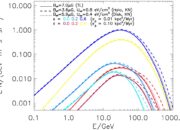In the realm of contemporary physics, dark matter represents one of the most tantalizing enigmas. Comprising a substantial part of the universe’s mass-energy content, its elusive nature has spurred fervent inquiry into potential manifestations and interactions. Among the most captivating hypotheses to emerge is that of “dark matter balls.” This phenomenon posits that these dense clumps of dark matter might be hurtling through the cosmos, perhaps even past our very own planet, thus implying the possibility of their explosive interactions with normal matter. The exploration of this concept not only addresses a common observation within astrophysics but also hints at profound implications regarding our understanding of the universe.
Dark matter, as it stands, is a theoretical construct introduced primarily to explain the discrepancies observed in galactic rotation curves and gravitational lensing phenomena. Despite accounting for approximately 27% of the universe’s total mass-energy density, dark matter remains imperceptible to electromagnetic radiation, making it exceedingly difficult to detect directly. Conventional matter, which interacts electromagnetically, forms stars, planets, and all visible structures. The variance in behavior between these two types of matter thus beckons inquiry into their potential interactions and effects.
Recent theoretical frameworks suggest that dark matter may exist not as a diffuse halo surrounding galaxies, but rather in more localized, structured forms, known as dark matter balls or clumps. These balls would derive from gravitational gravitational collapse mechanisms, analogous to the formation of stars but governed by dark matter’s unique properties. The notion that condensed dark matter could concentrate in specific regions of the universe introduces a captivating paradigm that links the abstract with the concrete, leading to implications that dramatically affect our cosmic narrative.
When contemplating the existence of dark matter balls, one may ponder their potential interaction with baryonic matter. A critical observation arises: The intersection between matter of different natures might yield explosive outcomes. If a dark matter ball were to pass through ordinary matter, or vice versa, the kinetic and gravitational interactions could result in phenomena analogous to cosmic explosions, releasing energy comparable to supernova events. Thus, the idea of these dark matter entities erupting under specific conditions alters our perception of cosmic events, hinting at a universe rife with unobserved yet impactful occurrences.
Moreover, the detection of such explosive phenomena might offer indirect evidence of dark matter’s existence. Current astrophysical observations encompass extensive surveys of cosmic background radiation, gravitational lensing archives, and galaxy clustering patterns. Nevertheless, the indirect implications of dark matter balls necessitate a fresh lens through which we can analyze and interpret this wealth of data. Instruments designed to catalog explosive events could be refined to search specifically for signatures that imply the remnants or interactions with dark matter balls, potentially bridging the gap between theoretical existence and empirical observation.
The allure of dark matter and its proposed localized clumping raises philosophical questions about our understanding of the universe. It provokes inquiry into the nature of existence itself and the underpinning forces that govern cosmic structures. Every galaxy, every cluster, seems to be punctuated by a mystery that permeates both scientific investigation and popular imagination. The hypothesized explosions resulting from dark matter balls challenge our very notion of what constitutes observable phenomena in the universe, suggesting that we are enveloped in a profound cosmic tapestry of dimensions and forces we have yet to fully understand.
Furthermore, the implications of dark matter balls extend into the realm of particle physics. The speculation surrounding their composition spurs the investigation of new particle candidates beyond the Standard Model. Supersymmetric particles, axions, or even more exotic entities could hypothetically constitute dark matter and provoke significant implications for fundamental physics. Each potential interaction or explosive event could pave the way for discoveries that reshape our theoretical frameworks and understanding of fundamental forces.
The fascination with dark matter balls does not merely lie in their theorized existence; it echoes the innate human desire to grasp that which we cannot see. This pursuit reflects our collective curiosity and the fundamental need to decipher the cosmos. Each hypothesis, each new model proposing interaction echoes the age-old query—what lies beyond the veil of our observable universe? This exploration into dark matter serves as a reminder of our infinitesimal place within the grand cosmic stage and the vast, predominantly undiscovered entities that may surround us.
In summary, the concept of dark matter balls and their potential explosive interactions with ordinary matter introduces a multidimensional layer of inquiry that incorporates cosmology, particle physics, and philosophy. As scientists continue to unravel the intricacies of dark matter, the potential for transformative discoveries remains profound. Indeed, understanding the nature of these dark phenomena not only informs us about the universe but also inspires a deeper appreciation of the complexities surrounding existence itself. Thus, as we probe deeper into this mysterious domain, we may be on the precipice of unveiling the very fabric of our universe.








